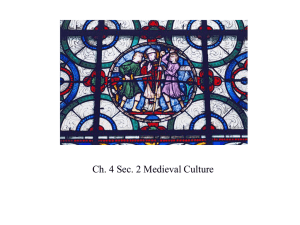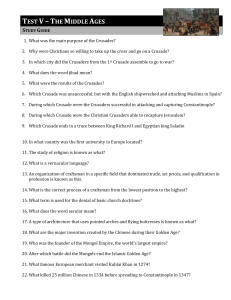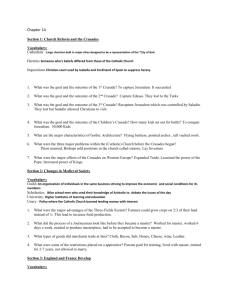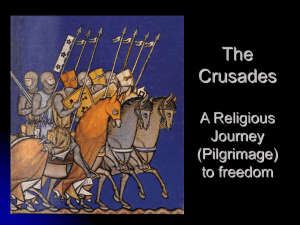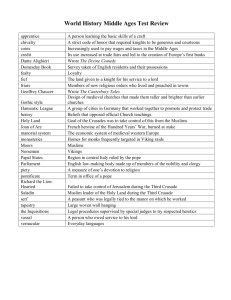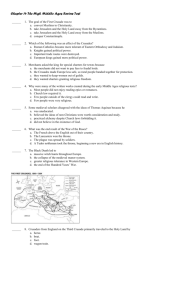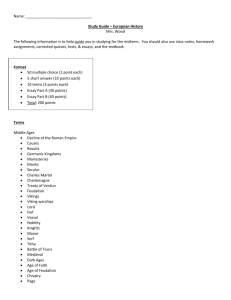File - Mr Wyka's Weebly
advertisement
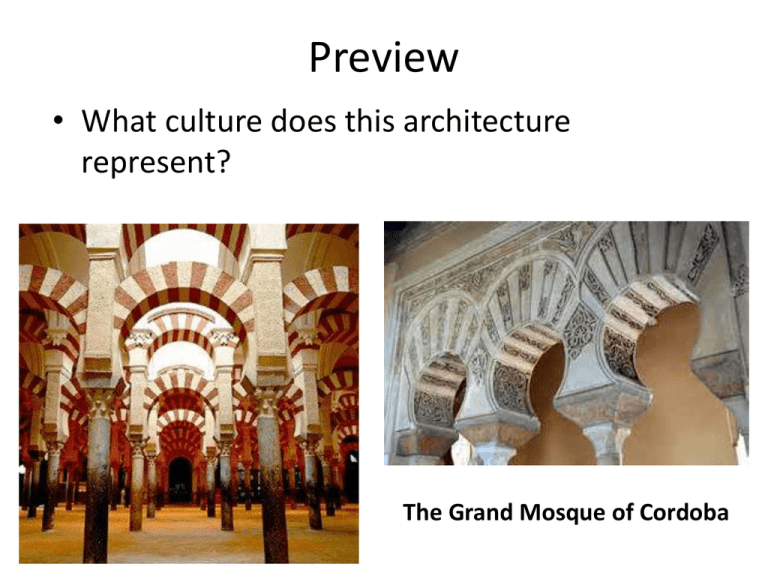
Preview • What culture does this architecture represent? The Grand Mosque of Cordoba Stoic – emotionless; unaffected by joy, grief, pleasure, or pain Pronunciation for Word • When playing poker, why is it important to keep a stoic expression on your face? (Questions, Reasons, Examples) Mar 18, Block 3 Stoic – emotionless; unaffected by joy, grief, pleasure, or pain Pronunciation for Word • What would the word stoic mean to a… • Judge • Police Officer (Words Across Contexts) Mar 18, Block 4 The Increasing Influence of Europe and The Crusades Ch 19 Bentley Essential Questions • How did the Church influence political and cultural changes in medieval Europe? • What were the proximate causes of the First Crusade? • What were the effects of the Crusades? Why does it matter? The Crusades remain in the imagination of peoples even today. Unfortunately, what many people think they know about the Crusades are a caricature of what really happened. It also matters because there will be a quiz on the content of this slideshow. You may use the notes you take during this lecture, during the quiz. Lesson Vocabulary • • • • Crusades infidel Byzantium Anatolia Knight Templar The Spread of Christianity in the first 600 years. In A.D. 622, the new religion of Islam swept out of the Arabian Peninsula In less than one hundred years, the armies of Islam swept across the Christian Middle East and North Africa, and even into Europe, spreading this new religion by Sword and Fire and promises of a very earthly paradise for it’s warriors. In less than one hundred years, the world went from this… To this… Muslim Armies even Defeated the armies of the mighty Christian Byzantine Empire and pushed their armies back right to the very gates of Constantinople itself. Constantinople, the grandest and largest Christian city in the world, and capital of the Byzantine Empire This prompted the emperor of Constantinople, Alexius I, to plead with the pope for aid against the Seljuk Turks, the Islamic people threatening the empire. The pope, Urban II, leader of the Catholic Church, called together all the lords and nobles of Europe to go the aid of their Christian brothers in Constantinople and to reclaim the ancient lands of Christianity, especially, Jerusalem, where Jesus had been put to death. “…your brethren who live in the east are in urgent need of your help, and you must hasten to give them the aid which has often been promised them. For, as the most of you have heard, the Turks and Arabs have attacked them and have conquered the territory of Romania [the Greek empire] as far west as the shore of the Mediterranean and the Hellespont, which is called the Arm of St. George. They have occupied more and more of the lands of those Christians, and have overcome them in seven battles. They have killed and captured many, and have destroyed the churches and devastated the empire. If you permit them to continue thus for awhile with impurity, the faithful of God will be much more widely attacked by them. On this account I, or rather the Lord, beseech you as Christ's heralds to publish this everywhere and to persuade all people of whatever rank, foot-soldiers and knights, poor and rich, to carry aid promptly to those Christians and to destroy that vile race from the lands of our friends.“ - Pope Urban II at the Council of Clermont in southern France, 1095 This was the FIRST CRUSADE The men of the FIRST CRUSADE, mostly Frankish knights, considered themselves Christians on pilgrimage. • They sewed cloth crosses on their surcoats to show they were pilgrims. • A pilgrim is a person on a spiritual, or religious journey. The 1st Crusade’s second siege of Antioch from a French manuscript The First Crusade • 1095-1099 • The only crusade to succeed in its goal of capturing Jerusalem. • The short lived Crusader / Latin kingdoms were established. The First Crusade Reasons: 1. To protect Christian pilgrims to the Holy Land. 2. To defend the Byzantines. 3. To reclaim lands lost to Muslim expansion, especially and primarily, the Holy Land. Lesson Vocabulary theology - The study of God vernacular – the language of the people chanson de geste – heroic epic Scholasticism - Philosophical system to reconcile faith and reason Thomas Aquinas - Dominican friar and champion of scholasticism. Wrote the Summa Theologica. Canonized – to be declared a saint, holy. Architecture Guiding Question: How did innovations change the architecture of churches and cathedrals in Europe? Architecture • The Romanesque style was popular in the 11th and 12th centuries. – Vaulted roofs and lots of pillars. – Dark with not a lot of windows. • The Gothic style appeared in the 12th century. – Used ribbed vaults and flying buttresses to support the massive masonry. – Allowed for lots and lots of windows. • Stained glass windows depicted Gospel scenes and scenes from the lives of saints. In the left frame: Saint-Sernin, Toulouse In the right frame: Amiens Cathedral Which is Gothic, which Romanesque? Remember the Guiding Question: How did innovations change the architecture of churches and cathedrals in Europe? • Innovations like the flying buttress and a combination of ribbed vaults and pointed arches allowed for a grander, higher, style of building with greater interior space and windows; Romanesque to Gothic. Universities Guiding Question: How did universities reflect the intellectual revival that occurred in Europe during the High Middle Ages? Universities • The modern university was a product of the European High Middle Ages. • The earliest universities were developed under the aegis of the Catholic Church, usually from cathedral schools or papal decree.* • Later they were also founded by kings and princes. • The first university was in Bologna, Italy. • The University of Paris and Oxford (England) were founded in the High Middle Ages. *Johnson, P. (2000). The Renaissance : a short history. Modern Library chronicles (Modern Library ed.). New York: Modern Library, p. 9.dministrations What Can You Discern from the Picture? Lecturing in a Medieval University by Laurentius De Voltolina (14th Century). Vernacular Literature Guiding Question: Why was the development of vernacular literature important during the High Middle Ages? Vernacular Literature • Latin was the universal language of medieval Europe. • In the 12th century, literature began to be written in the vernacular – the language of everyday speech. – Troubadour poetry. – Chanson de geste – heroic epic. The earliest and finest example of this is The Song of Roland. – The Canterbury Tales of English author Geoffrey Chaucer. Page from the manuscript of the SONG OF ROLAND, early Frankish epic. Remember the Guiding Question: Why was the development of vernacular literature important during the High Middle Ages? • Vernacular literature bolstered national identity and gradually brought about the codification of European languages.
